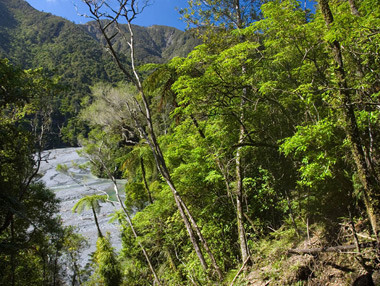 Podocarp-broadleaf forest (Orongorongo River, Rimutaka Forest Park). Photographer: Jeremy Rolfe.Podocarp broadleaved forests are typically found in the lowlands, on both alluvial terraces and hill slopes. They are most abundant in the North Island, West Coast, and Southland, and on Stewart Island.
Podocarp-broadleaf forest (Orongorongo River, Rimutaka Forest Park). Photographer: Jeremy Rolfe.Podocarp broadleaved forests are typically found in the lowlands, on both alluvial terraces and hill slopes. They are most abundant in the North Island, West Coast, and Southland, and on Stewart Island.
On lowland river terraces podocarp species dominate with kahikatea often the most common tree, especially on wet soils. On more fertile and better drained soils it often grows in association with matai and totara. Broadleaved trees are more common on hill slopes, with kamahi abundant in wetter and cooler regions, while in the North Island tawa is often dominant. These species often grow in association with rimu, miro and, locally, matai and northern rata.

 Podocarp-broadleaf forest (left: Smith Creek, Tararua Forest Park; right: Lake Matheson). Photographer: Jeremy Rolfe.
Podocarp-broadleaf forest (left: Smith Creek, Tararua Forest Park; right: Lake Matheson). Photographer: Jeremy Rolfe.
To read about New Zealand’s other indigenous forest types follow these links:
For more information about podocarp broadleaved forests see:
- Video about forests (and wetlands) in South Westland featuring Sir Alan Mark
- Dynamics of upland podocarp - broadleaved forest on Mamaku plateau, central North Island, New Zealand by Mark Smale, Bruce Burns and Patrick Whaley (Journal of tje Royal Society)
- Life history of the New Zealand Conifer Broadleaf Forest by John Dawson (From Forest Vines to Snow Tussocks)
- Podocarp - hardwood forests (DOC website)
- Podocarp - hardwood forests factsheet (DOC website, File size 361K)
